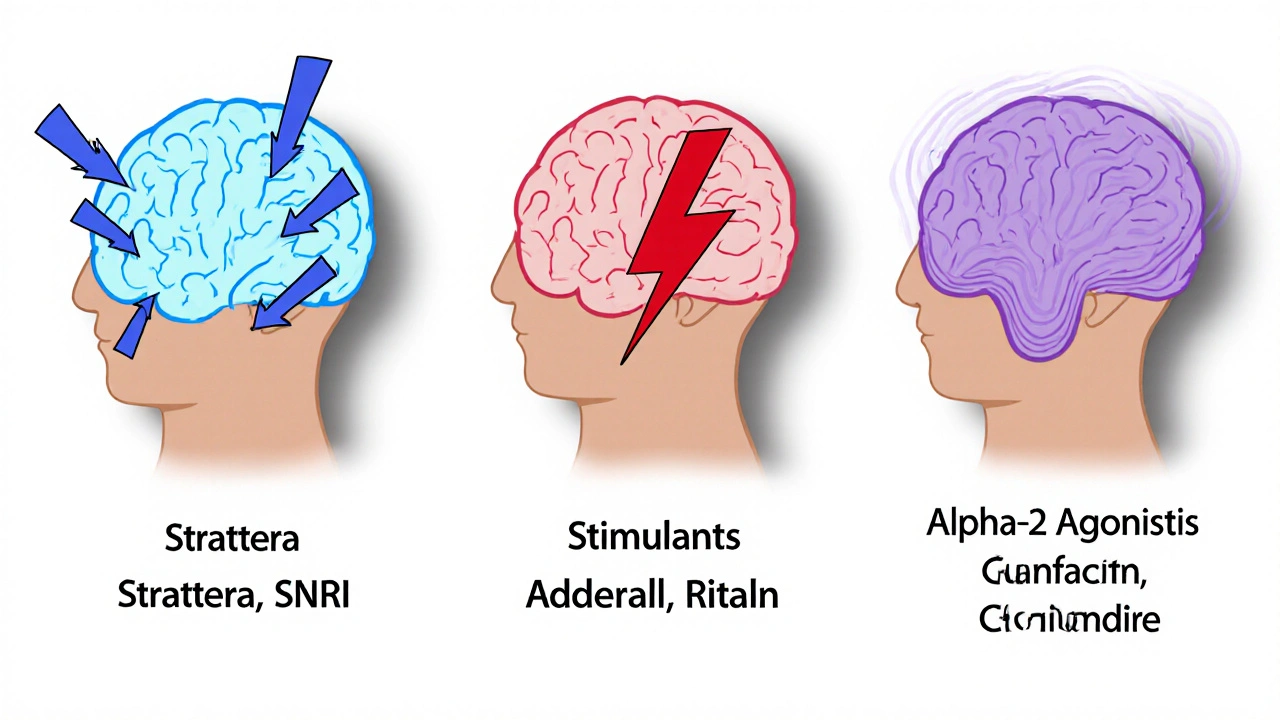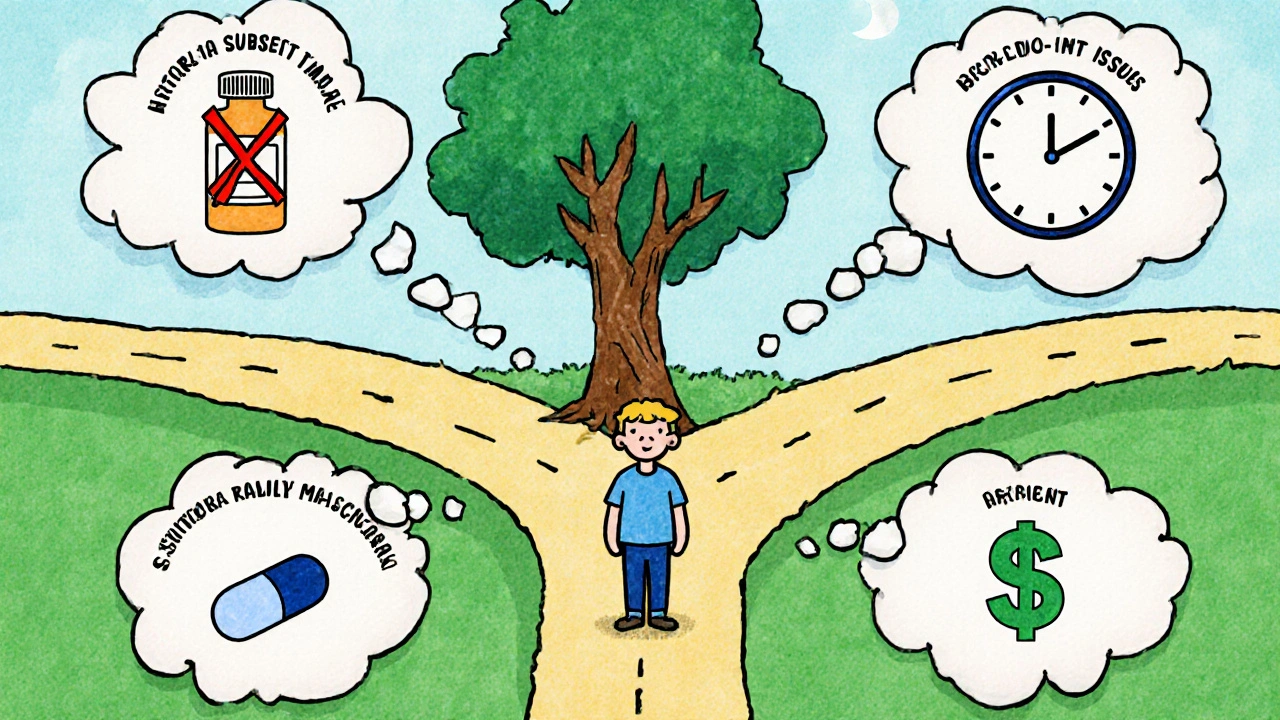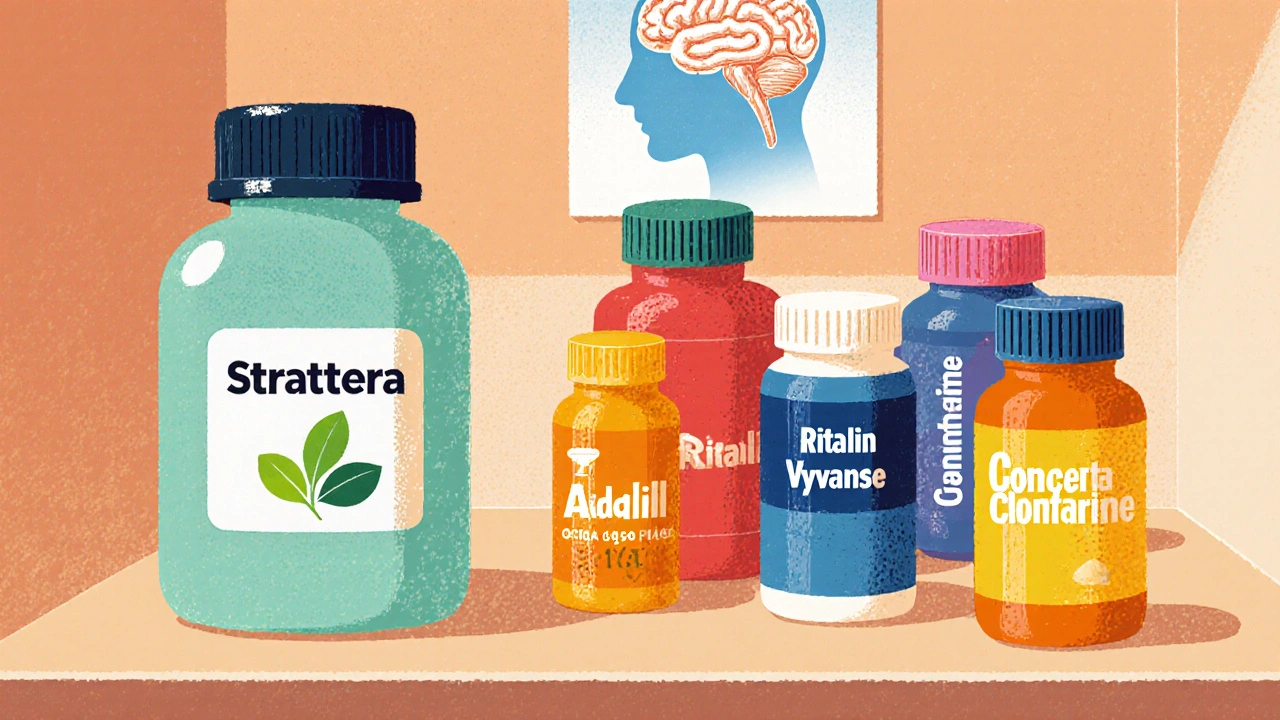ADHD Medication Selector
Personalize Your Medication Choice
Answer these questions to get personalized recommendations for ADHD medications.
Quick Takeaways
- Strattera is the only non‑stimulant FDA‑approved for ADHD; it works by boosting norepinephrine.
- Stimulants such as Adderall and Ritalin act faster but carry higher abuse potential.
- Extended‑release options (Vyvanse, Concerta) smooth out symptom control throughout the day.
- Alpha‑2 agonists (Guanfacine, Clonidine, Intuniv) are useful for comorbid anxiety or sleep issues.
- Choosing the right drug depends on symptom profile, age, comorbidities, and lifestyle.
When doctors talk about non‑stimulant options for ADHD, Strattera (Atomoxetine) is the name that crops up most often. It was approved in the U.S. in 2002 and later received approval from the UK's MHRA. Unlike the more common stimulants, Strattera isn’t a controlled substance, which makes it attractive for people worried about misuse.
But is it the best fit for everyone? Below we break down how Strattera stacks up against the most frequently prescribed alternatives, looking at efficacy, onset, side‑effect profile, abuse risk, and practical considerations like dosing frequency.
How Strattera Works
Strattera belongs to the class of selective norepinephrine reuptake inhibitors (SNRIs). By blocking the norepinephrine transporter, it increases the amount of norepinephrine in the synaptic cleft, improving attention and reducing impulsivity. The effect builds gradually, often taking 4-6 weeks to reach full therapeutic benefit.
Stimulant Heavyweights
Adderall is a mixed‑amphetamine formulation that boosts dopamine and norepinephrine. Its action starts within 30‑60 minutes, making it a go‑to for rapid symptom control.
Ritalin (methylphenidate) works similarly by blocking dopamine and norepinephrine reuptake. It’s available in short‑acting and extended‑release forms, giving flexibility for school‑day versus weekend dosing.
Both Adderall and Ritalin are classified as Schedule II controlled substances in the U.S. and are subject to stricter prescribing rules in the UK, reflecting their higher abuse potential.
Extended‑Release Stimulants
Vyvanse (lisdexamfetamine) is a pro‑drug that converts to dextroamphetamine after ingestion. This design smooths out the rise and fall of blood levels, often lasting 10‑14 hours.
Concerta delivers methylphenidate via an osmotic pump, providing a steady release for up to 12 hours. It’s a popular once‑daily option for school‑aged children.

Alpha‑2 Agonist Alternatives
Guanfacine (brand name Intuniv for the extended‑release form) works by stimulating alpha‑2A receptors in the prefrontal cortex. It reduces hyperactivity and improves working memory without stimulating dopamine pathways.
Clonidine (often prescribed as Kapvay in extended‑release) has a similar mechanism but is more sedating, making it handy for kids who also struggle with insomnia.
Intuniv is simply the brand name for the extended‑release guanfacine tablet; it’s mentioned separately because many clinicians refer to it by its brand name when discussing dosing schedules.
Side‑Effect Snapshot
Understanding side effects helps narrow down the right choice. Below is a concise comparison.
| Medication | Onset | Typical Duration | Abuse Potential | Common Side Effects |
|---|---|---|---|---|
| Strattera (Atomoxetine) | 1‑2 weeks (full effect 4‑6 weeks) | 24 hours (once‑daily) | Low | Dry mouth, nausea, insomnia, slight weight loss |
| Adderall | 30‑60 minutes | 4‑6 hours (immediate‑release) | High | Appetite suppression, insomnia, increased BP, anxiety |
| Ritalin | 20‑30 minutes | 3‑4 hours (short‑acting) | High | Stomach upset, jitteriness, headache |
| Vyvanse | 1‑2 hours | 10‑14 hours | Moderate (pro‑drug reduces peaks) | Decreased appetite, dry mouth, irritability |
| Concerta | 1‑2 hours | 10‑12 hours | Moderate | Insomnia, stomach pain, weight loss |
| Guanfacine (Intuniv) | 1‑2 hours | 24 hours | Low | Drowsiness, low blood pressure, fatigue |
| Clonidine (Kapvay) | 30‑60 minutes | 8‑12 hours | Low | Sleepiness, dry mouth, low BP |
When to Choose Strattera
Strattera shines in a few specific scenarios:
- History of substance misuse: because it isn’t a controlled substance, it avoids the legal and monitoring hassles of stimulants. \n
- Co‑occurring anxiety or tic disorders: stimulants can exacerbate these; a non‑stimulant may be safer.
- Adult ADHD: many adults appreciate a once‑daily pill without the “high‑then‑crash” pattern.
- Family preference for non‑stimulants: some parents or patients are wary of stimulant stigma.
On the flip side, if rapid symptom control is critical-say, for a student needing immediate focus during exams-a stimulant may be more appropriate.

Cost and Access Considerations
In the UK, Strattera is prescription‑only and usually priced higher than generic methylphenidate, which is widely available through the NHS. However, private insurance plans often cover it if a stimulant trial fails. In the US, Strattera’s generic version (atomoxetine) became available in 2015, bringing the price down to roughly $120‑$150 for a month’s supply, still pricier than many generics but comparable to brand‑name stimulants.
Practical Tips for Starting Strattera
- Begin with a low dose (usually 40 mg once daily) and titrate up over 2‑3 weeks.
- Take it with or without food, but stay consistent each day.
- Monitor blood pressure and heart rate at baseline and after dose increases.
- Be patient-full benefit may not appear until week 4‑6.
- If severe nausea occurs, try taking the pill with a small snack.
Decision‑Tree: Picking the Right ADHD Medication
Use the following quick flow to narrow options:
- Is there a history of substance misuse? → Yes: consider Strattera, Guanfacine, or Clonidine. No: move to 2.
- Do you need rapid onset (e.g., for exam prep)? → Yes: stimulant (Adderall, Ritalin, Vyvanse). No: continue.
- Are sleep problems a major issue? → Yes: non‑stimulant or alpha‑2 agonist. No: any option could work.
- Is cost a primary concern? → Yes: generic methylphenidate (Ritalin) or generic amphetamine (Adderall). No: Strattera or Vyvanse are viable.
Bottom Line
Strattera offers a unique non‑stimulant pathway for ADHD management, making it a solid fallback when stimulants aren’t suitable. It trades speed for safety, and its side‑effect profile sits somewhere in the middle-dry mouth and mild insomnia are common, but serious cardiovascular concerns are rare. When you compare it side‑by‑side with stimulants like Adderall, Ritalin, Vyvanse, and extended‑release options such as Concerta, or with alpha‑2 agonists like Guanfacine and Clonidine, the choice boils down to three questions: risk of misuse, need for quick symptom relief, and how side effects line up with personal health history.
How long does it take for Strattera to start working?
Patients usually notice a subtle improvement after 1‑2 weeks, but the full therapeutic effect often emerges around 4‑6 weeks of consistent dosing.
Is Strattera habit‑forming?
No. Strattera is not classified as a controlled substance and has a low potential for dependence or abuse.
Can adults take Strattera?
Yes. Strattera is approved for adults with ADHD and is often chosen because it avoids the jittery “high‑low” cycle of stimulants.
What are the main differences between Strattera and Vyvanse?
Vyvanse is a stimulant that works faster (1‑2 hours) and has a higher abuse risk. Strattera works slower (weeks) but is non‑stimulant and not a controlled drug.
When should I consider an alpha‑2 agonist instead of Strattera?
If you have prominent anxiety, sleep problems, or blood‑pressure concerns, guanfacine or clonidine may be gentler than Strattera’s norepinephrine boost.


Sameer Khan
Strattera (atomoxetine) operates as a selective norepinephrine reuptake inhibitor, which distinguishes it mechanistically from dopaminergic stimulants.
By augmenting synaptic norepinephrine, it modulates prefrontal cortical networks implicated in sustained attention and impulse control.
The pharmacokinetic profile entails a steady plasma concentration achievable with once‑daily dosing, thereby simplifying adherence.
Therapeutic onset is characteristically delayed, with discernible benefits emerging between one to two weeks and maximal effect by four to six weeks.
This latency contrasts sharply with the rapid onset of amphetamine or methylphenidate formulations, which act within minutes to hours.
Adverse effect spectrum of Strattera includes xerostomia, gastrointestinal discomfort, insomnia, and modest weight loss, largely reflective of its central noradrenergic activity.
Cardiovascular monitoring remains prudent given potential elevations in blood pressure and heart rate, albeit less pronounced than stimulant‑induced tachycardia.
Crucially, Strattera is not classified as a controlled substance, mitigating concerns surrounding pharmacovigilance and diversion.
Such regulatory status renders it advantageous for patients with a documented history of substance misuse or for caregivers apprehensive about stimulant stigma.
In comparative efficacy analyses, stimulant agents often demonstrate superior effect size metrics in short‑term symptom reduction.
Nevertheless, the magnitude of functional improvement with atomoxetine becomes comparable in longer‑term trials, particularly when comorbid anxiety is present.
Alpha‑2 agonists such as guanfacine or clonidine may be preferred when hypersomnolence dominates the clinical picture, given their sedative profile.
Conversely, for individuals requiring rapid cognitive augmentation-e.g., during exam preparation-stimulants retain a pragmatic edge.
Cost considerations vary geographically; generic atomoxetine offers a moderate price point in the United States, though it may be out‑priced by generic methylphenidate on public formularies.
Clinicians should therefore individualize therapeutic selection based on misuse risk, onset urgency, side‑effect tolerability, and socioeconomic factors.
Ultimately, Strattera provides a viable non‑stimulant alternative that balances safety with efficacy when patient circumstances align with its pharmacological attributes.
Tim Blümel
Reading through the comparison, I appreciate how the article lays out both the speed and safety dimensions of each option.
For many adults, the gradual onset of Strattera feels less “jarring” than the stimulant “high‑low” swing 😊.
One practical tip is to pair the first few weeks of atomoxetine with a low‑dose sleep aid if insomnia becomes noticeable.
Monitoring blood pressure weekly can catch the modest elevations that sometimes accompany norepinephrine increases.
If rapid focus is needed-for instance, during a big presentation-a short‑acting stimulant can be used as a bridge while Strattera ramps up.
It’s also worth noting that the non‑controlled status removes the paperwork headaches for clinicians and patients alike.
Overall, the side‑effect profile of Strattera feels manageable, especially when dietary adjustments address dry mouth and nausea.
Stay patient, and give the medication the full 4‑6 weeks to show its true benefit! 🙂
Joanne Ponnappa
I like the clear table that shows onset and side‑effects at a glance.
The non‑stimulant option seems less likely to cause appetite loss, which is important for kids.
If you have trouble sleeping, guanfacine might be a gentler choice than Strattera.
Cost can be a big factor – generic Ritalin is often cheaper in the UK.
Overall, it’s good to have a few different tools to match each person’s needs.
Emily Collins
While the supportive tone is comforting, the reality of waiting six weeks for noticeable improvement can feel torturous for patients desperate for relief.
The delayed gratification inherent to Strattera may drive some to abandon treatment prematurely, seeking the instant “rush” of stimulants.
This underlines a systemic issue: our healthcare model often favors quick fixes over patience‑building therapies.
Moreover, the side‑effects like chronic dry mouth can become a daily annoyance that erodes quality of life.
It’s crucial to set realistic expectations early, lest frustration leads to non‑adherence.
Jai Reed
The preceding analysis correctly outlines pharmacodynamics, yet it glosses over the real‑world impact of the delayed onset.
Patients cannot afford to wait weeks while academic or occupational demands mount.
In many cases, clinicians prescribe a stimulant adjunct to bridge the gap, effectively undermining the “non‑stimulant” claim.
This hybrid approach introduces additional side‑effects and complicates dosing schedules.
Furthermore, the cardiovascular monitoring recommendation, while prudent, adds another layer of clinical burden that many primary‑care settings are ill‑equipped to manage.
Cost‑effectiveness also demands scrutiny: generic stimulants often out‑price atomoxetine by a substantial margin.
Therefore, positioning Strattera as a primary monotherapy without acknowledging these constraints is misleading.
WILLIS jotrin
Emily raises a valid point about patient patience, especially when symptom relief feels distant.
One strategy is to implement behavioral interventions concurrently, which can mitigate the perceived lag in medication efficacy.
Structured routines, mindfulness exercises, and targeted cognitive training have shown additive benefits alongside atomoxetine.
These non‑pharmacologic measures can sustain motivation and reduce the temptation to switch prematurely to stimulants.
Overall, a multimodal plan respects both the pharmacologic timeline and the patient’s immediate functional needs.
Kiara Gerardino
It is unconscionable to trivialize the socioeconomic disparity that dictates whether a patient receives Strattera or a cheap generic stimulant.
The healthcare system’s bias towards cost‑cutting overlooks the ethical imperative to provide the safest profile for vulnerable individuals.
Choosing a drug solely on price without considering abuse potential is a dereliction of professional duty.
Patients with a history of substance misuse deserve the non‑controlled alternative, regardless of the marginal cost increase.
To perpetuate a one‑size‑fits‑all model is to ignore the nuanced realities of comorbid anxiety and sleep disturbances.
We must champion patient‑centered prescribing that elevates safety over budgetary convenience.
Diane Thurman
Kiara, your moral high ground is a bit overblown. Not evryone can afford Strattera, and doctors have to work within real budget constraints.
Sometimes the cheap stimulents do the job just fine, so why make a fluff about safety?
It's not always about "abuse potential" – many patients handle stimulants responsibly.
Let's be realistic about what the NHS can actually provide.
Sarah Riley
In practice, atomoxetine's delayed onset often necessitates adjunctive short‑acting stimulant coverage.